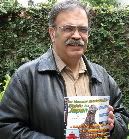From the L.A. Times:
Paul Tibbets, pilot who bombed Hiroshima, dies at 92
By Eric Malnic, Special to The Times
9:40 AM PDT, November 1, 2007
Paul Warfield Tibbets Jr., the Army Air Forces pilot whose bombing run over Hiroshima, Japan, in 1945 introduced nuclear war, died today at his home in Columbus, Ohio. He was 92.
Tibbets suffered from a variety of ailments and died of heart failure, said Gerry Newhouse, a longtime friend.
Retired Brig. Gen. Paul Tibbets
click to enlargeHe never apologized for unleashing the devastating explosive force and insidious nuclear radiation that leveled more than two-thirds of the buildings in Hiroshima and killed at least 80,000 people, and perhaps as many as 127,000.
To him and millions of supporters, dropping the atomic bomb was a justifiable means of shortening World War II, preserving the lives of up to a million American servicemen that military experts said might have died in a final Allied invasion of Japan.
"I never lost a night's sleep over it," Tibbets said.
But to millions of detractors, the nuclear attack on Hiroshima was a cosmic example of man's inhumanity to man, an act that left the world teetering on the brink of self-annihilation.
"I made one great mistake in my life -- when I signed a letter to President [Franklin D.] Roosevelt recommending that an atomic bomb be made," said pioneering physicist Albert Einstein, one of the first to conceive of such a weapon.
Tibbets was more than just the pilot of the Enola Gay, the propeller-driven, four-engine bomber, named for his mother, that dropped the bomb on Hiroshima on Aug. 6, 1945.
Described by his commandant, Gen. H.H. (Hap) Arnold as "the best damned pilot in the [Army] Air Force," Tibbets was hand-picked to command the mysterious 509th Composite Group, the first military unit ever formed to wage nuclear war. Three days after the bombing of Hiroshima, another plane from the 509th leveled much of Nagasaki with another nuclear bomb, prompting the Japanese surrender.
Tibbets chose the planes that flew those missions -- specially reconfigured B-29s, then the largest operational aircraft on Earth, stripped of armament and armor plating to lighten them for their extended journeys.
He selected the combat veterans who manned the bombers. Many of the crewmen were personal friends who had flown missions with him over Nazi-occupied Western Europe and North Africa.
Tibbets picked an isolated air base straddling the Nevada-Utah border where the men of the 509th trained for their ultra-secret mission. And he drove his men hard, weeding out those who fell short or talked too much about what they were doing.
Proud, prickly and a perfectionist, Tibbets never doubted that he was the man for the job.
Pilot of "Enola Gay" Dies
Moderator: Controllers
9 posts
• Page 1 of 1
-

armandv - Heisei Godzilla
- Posts: 1757
- Joined: Sat Aug 09, 2003 12:30 am
- Location: Tarzana, California (somewhere near Hollywood)
I'm slightly curious as to the origin of his "variety of ailments" and if it had anything to do with his job - but then, the man was 92.
It'd be easy to condemn him for the bombings, or even to note that he had it better than victims at Hiroshima, but there's a long list of people to blame ahead of him, if you wish, for dropping those nuclear bombs.
It'd be easy to condemn him for the bombings, or even to note that he had it better than victims at Hiroshima, but there's a long list of people to blame ahead of him, if you wish, for dropping those nuclear bombs.

-

Baltan II - Burning Godzilla
- Posts: 2494
- Joined: Wed Sep 24, 2003 2:27 am
- Location: Pennsylvania
- Robert Saint John
- Burning Godzilla
- Posts: 2321
- Joined: Tue Jul 29, 2003 8:40 pm
- Location: Cleveland, OH
Check out this site instead: http://www.fas.org/nuke/guide/japan/nuke/
I'm not familiar with the site, but it appears well researched and if the About FAS is legit () the info should be taken pretty seriously.
I'm not familiar with the site, but it appears well researched and if the About FAS is legit () the info should be taken pretty seriously.
-

Glow-nut - Godzilla Jr.
- Posts: 428
- Joined: Sat Aug 16, 2003 12:52 pm
9 posts
• Page 1 of 1
Who is online
Users browsing this forum: No registered users and 8 guests
